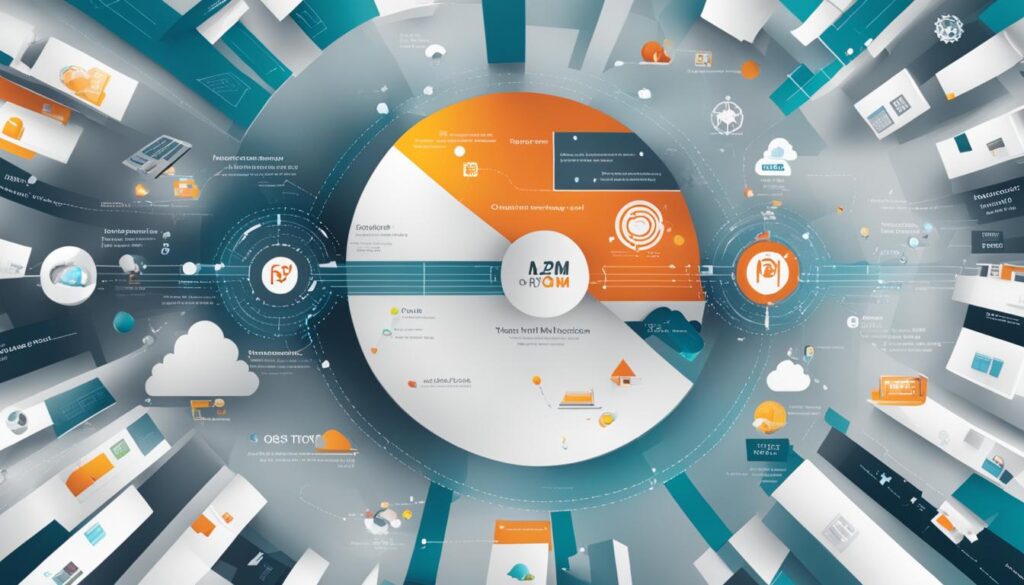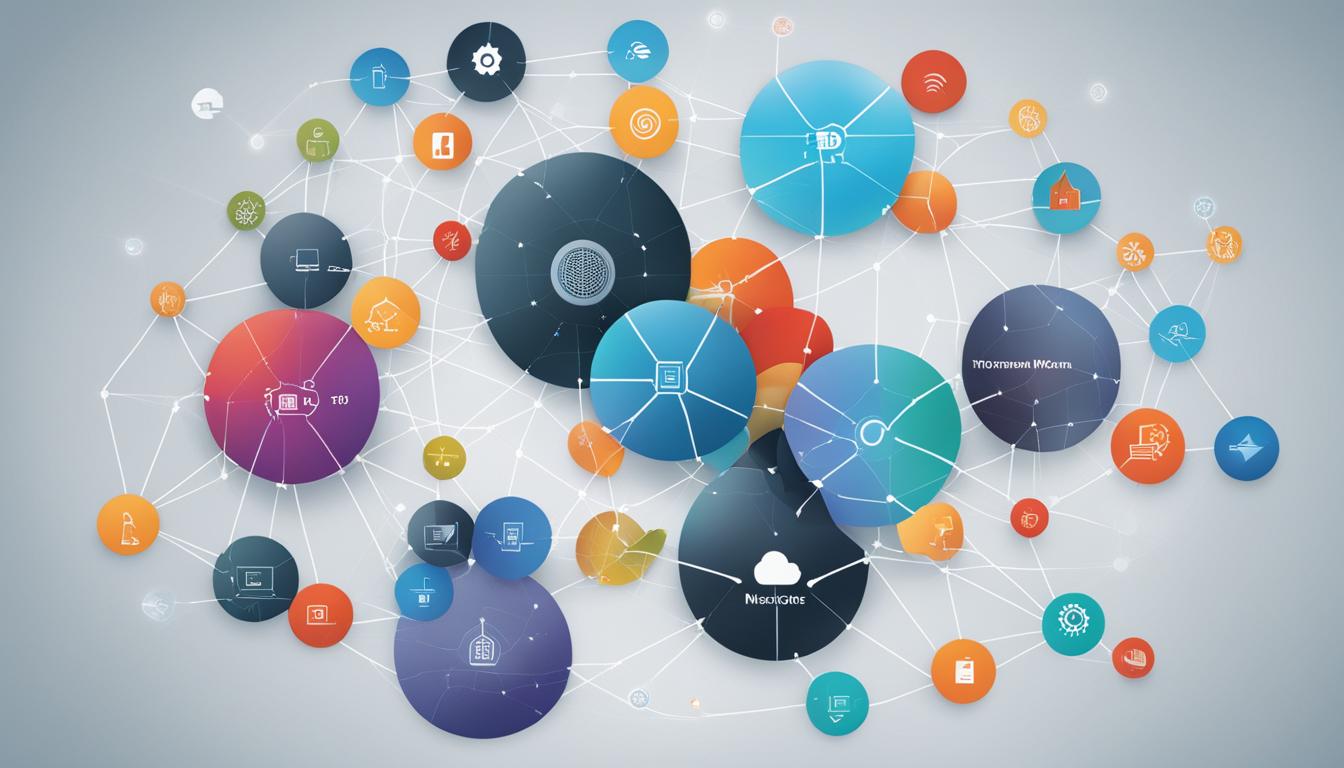The world of technology is constantly evolving, with new advancements and innovations shaping the way we live and work. Two terms that are often used interchangeably are the Internet of Things (IoT) and Machine-to-Machine (M2M) technologies. While they may seem similar at first glance, there are distinct differences between the two that are important to understand.
Key Takeaways:
- The Internet of Things (IoT) refers to the network infrastructure that connects objects to the Internet, while M2M communication involves direct communication between machines.
- IoT devices require an active Internet connection for communication, whereas M2M devices are not dependent on the Internet.
- IoT offers greater scalability, interoperability, and supports both B2B and B2C models, while M2M is primarily used for B2B interactions.
- IoT devices have a certain degree of intelligence and can share data with other applications, while M2M technology typically lacks the same level of intelligence and data sharing capabilities.
- Both IoT and M2M have applications in various industries, with IoT being used in areas such as smart wearables and big data, while M2M is commonly used in industrial applications like smart grids and remote patient monitoring.
IoT vs M2M: Connection and Communication
In the world of connected devices, the Internet of Things (IoT) and Machine-to-Machine (M2M) technologies play a significant role in enabling communication between devices. However, there are notable differences in the connection types and communication protocols used by these two technologies.
IoT devices are connected to the Internet using various communication types, allowing for cloud communication. Through networks and Internet protocols like HTTP, FTP, and Telnet, IoT devices can seamlessly send and receive data. This enables devices to interact with cloud platforms and exchange information with other connected devices, creating a truly interconnected ecosystem.
On the other hand, M2M communication involves a direct point-to-point connection between machines. This means that M2M devices communicate directly with each other, without the need for an Internet connection. Traditional protocols and communication technologies are used for data exchange in M2M, making it more suitable for certain applications where direct, secure communication is essential.
The table below summarizes the key differences in the connection and communication aspects of IoT and M2M technologies:
| Aspect | IoT | M2M |
|---|---|---|
| Connection Type | Internet-based | Direct point-to-point |
| Communication Protocols | HTTP, FTP, Telnet, etc. | Traditional protocols |
| Dependency on Internet | Dependent | Not dependent |
By understanding the differences in connection and communication, businesses and developers can better determine which technology is most suitable for their specific use cases and requirements.
Intelligence and Data Sharing in IoT and M2M
When comparing IoT and M2M technologies, one notable difference lies in the level of intelligence and data sharing capabilities. In the IoT ecosystem, devices are equipped with decision-making capabilities and a certain degree of intelligence. This allows them to process and analyze data, making informed decisions based on specific parameters. Additionally, IoT devices have the ability to share data not only with the communicating parties but also with other applications, enabling seamless integration and enhanced user experiences.
On the other hand, M2M technology generally lacks the same level of intelligence observed in IoT devices. M2M communication primarily involves direct communication between machines without significant data analysis or processing. Consequently, data sharing in M2M is limited to the communicating parties themselves. This means that M2M devices typically exchange data exclusively with each other, without the ability to extend data sharing to external applications or systems.
While IoT embraces a more intelligent and expansive approach to data sharing, M2M technology focuses on direct communication between specific machines. These differing capabilities have implications for the types of applications that can be developed and the extent to which data can be leveraged for insights and optimizations.
Key Features of IoT and M2M Technologies
| IoT | M2M |
|---|---|
| Devices have decision-making capabilities and intelligence. | Devices primarily focus on direct communication with limited data processing. |
| Data sharing extends beyond communicating parties to other applications. | Data sharing is typically confined to the communicating parties themselves. |
| Enables seamless integration with external systems through open APIs. | Does not offer open API support, limiting integration capabilities. |
In summary, the intelligence and data sharing capabilities differ significantly between IoT and M2M technologies. While IoT devices possess decision-making abilities and can share data with external applications, M2M devices primarily rely on direct communication between themselves. Understanding these distinctions is crucial for businesses seeking to leverage IoT or M2M technologies for optimal functionality and data utilization.
IoT and M2M: Network and Scalability
When it comes to network infrastructure and scalability, IoT and M2M technologies have their own unique characteristics. IoT, being a more evolved concept, offers flexible and fast networks by connecting assets to the Internet and centralizing data to the cloud. This allows for seamless communication between devices and enables the integration of various applications. In contrast, M2M relies on direct point-to-point connections, making scalability more labor-intensive. M2M connections are limited to devices that are programmed to communicate with each other, resulting in a more rigid and less scalable network structure.
To further illustrate the differences, consider the following table:
| IoT | M2M | |
|---|---|---|
| Network Type | Cloud-based network infrastructure | Point-to-point connections |
| Scalability | Highly scalable due to cloud-based architecture | Less scalable due to limited point-to-point connections |
| Integration | Allows integration with various applications | Limited integration capabilities |
As shown in the table, the network type of IoT is cloud-based, enabling greater scalability compared to the point-to-point connection of M2M. Additionally, IoT allows for seamless integration with various applications, expanding its capabilities beyond M2M technology.
Overall, IoT offers more flexibility, faster networks, and greater scalability due to its cloud-based architecture. This makes it suitable for a wide range of applications that require extensive connectivity and data exchange. On the other hand, M2M is more suited for specific use cases with a limited number of devices that require direct communication without the need for Internet connectivity. Understanding the differences between network and scalability features in IoT and M2M is crucial in determining the most suitable technology for specific business and industrial needs.
IoT and M2M: Business Type and Open API Support
When it comes to business type and open API support, there are notable differences between IoT and M2M technologies. IoT, or the Internet of Things, offers a wide range of business models, catering to both Business-to-Business (B2B) and Business-to-Consumer (B2C) interactions. This flexibility makes IoT suitable for various applications and industries. Additionally, IoT provides open API support, allowing for greater customization and integration with external systems.
On the other hand, M2M, or Machine-to-Machine communication, predominantly focuses on Business-to-Business (B2B) interactions. It is commonly used in specialized industrial applications, such as smart grids, retail, remote patient monitoring, agriculture, and smart cities. However, M2M technology does not offer open API support, limiting its ability to seamlessly integrate with external systems.
To summarize, IoT supports both B2B and B2C business models and provides open API support, making it versatile and adaptable to different use cases. M2M, on the other hand, is primarily used in B2B interactions and lacks open API support. Understanding these differences is crucial when considering the right technology for your business needs.

| IoT | M2M |
|---|---|
| Supports both B2B and B2C models | Primarily used for B2B interactions |
| Offers open API support | Does not provide open API support |
| Wide range of applications and industries | Specialized industrial applications |
Key Takeaways:
- IoT supports both B2B and B2C business models, while M2M primarily focuses on B2B interactions.
- IoT offers open API support, facilitating integration with external systems, whereas M2M lacks open API support.
- IoT has a wider range of applications and industries compared to M2M, which is often used in specialized industrial settings.
Advantages and Disadvantages of IoT and M2M
When comparing IoT and M2M technologies, it’s important to understand the advantages and disadvantages of each. IoT offers several advantages over M2M, making it a popular choice for many applications. One of the key advantages of IoT is its ability to support cloud communication. This allows for more advanced functionalities and data analytics. By connecting devices to the cloud, IoT enables real-time data processing, storage, and analysis, leading to improved decision-making and operational efficiency.
Another advantage of IoT is its larger scope for devices. IoT technology can connect a wide variety of devices, including consumer electronics, industrial equipment, and even vehicles. This broader device connectivity allows for a more information and service-centric approach, enabling innovative applications in various industries.
However, it’s important to note that IoT also has its limitations. One disadvantage is that IoT devices often require generic commodity hardware, which may not be suitable for all applications. In certain scenarios, specialized hardware may be necessary, making M2M a more viable option. M2M technology is more hardware-centric and offers a more communication and device-centric approach. It is commonly used in specialized industrial applications where specific hardware requirements are critical.
| Advantages of IoT over M2M Technologies | Disadvantages of M2M compared to IoT Technologies |
|---|---|
| Supports cloud communication and advanced functionalities | Relies on specific hardware, limiting flexibility |
| Allows for a larger scope of device connectivity | Offers a more communication and device-centric approach |
| Enables real-time data processing and analytics | May require more labor-intensive scalability |
In conclusion, both IoT and M2M have their own advantages and disadvantages. IoT offers more advanced functionalities, scalability, and interoperability, making it suitable for a wide range of applications. On the other hand, M2M is more hardware-based and offers a more communication and device-centric approach, making it ideal for specialized industrial applications. Understanding these differences is crucial for businesses looking to leverage IoT and M2M technologies to improve efficiency and decision-making.
IoT vs M2M: Industrial Applications and Use Cases
In today’s interconnected world, both IoT and M2M technologies have found their place in various industries, revolutionizing operations and enhancing efficiency. Let’s explore some of the industrial applications and use cases for both these technologies.
Industrial Applications of IoT
IoT has made significant strides in numerous sectors, improving productivity and enabling smarter decision-making. Here are a few industrial applications of IoT:
- Smart Wearables: IoT enables the development of wearable devices that track health parameters, monitor worker safety, and improve overall well-being.
- Big Data and Cloud: IoT generates massive amounts of data that can be stored and analyzed in the cloud, providing insights for predictive maintenance, supply chain optimization, and more.
- Smart Grids: IoT enables efficient energy management by connecting power grids, meters, and control systems, leading to better monitoring and optimization of power distribution.
- Smart Cities: IoT helps create intelligent urban environments by connecting various systems such as transportation, waste management, and public safety, leading to improved quality of life for citizens.
Industrial Applications of M2M
M2M technology is widely used in several industrial sectors, particularly those that require direct machine communication without human intervention. Some notable use cases include:
- Retail: M2M enables inventory management, automated checkout systems, and remote monitoring of retail spaces, improving operational efficiency and customer experience.
- Remote Patient Monitoring: M2M facilitates the remote monitoring of patients, allowing healthcare providers to gather real-time data and provide timely interventions.
- Agriculture: M2M technology is employed in precision farming, enabling farmers to monitor soil moisture, temperature, and other variables, optimizing water usage and crop yield.
- Smart Factories: M2M enables efficient communication and control of machinery, facilitating remote diagnostics and minimizing downtime in manufacturing processes.
These are just a few examples of how IoT and M2M technologies are transforming industries worldwide. The ability to collect and analyze real-time data from connected devices through IoT and M2M solutions offers immense potential for improving operational efficiency, productivity, and asset management.
Conclusion
Understanding IoT and M2M technologies is crucial in today’s interconnected world. While both technologies involve connecting devices and enabling machine-to-machine communication, there are key differences that businesses should consider.
IoT offers advanced functionalities, scalability, and interoperability. With cloud communication and open API support, it provides a wide range of applications and customization options. On the other hand, M2M is more hardware-based and suitable for specialized industrial applications.
By leveraging IoT, businesses can enhance operational efficiency, improve decision-making, and harness the power of big data. However, M2M technology still plays a significant role in industries such as smart grids, retail, and healthcare.
In summary, understanding the key differences between IoT and M2M technologies empowers businesses to choose the most appropriate solution for their specific needs and goals. Whether it’s the advanced functionalities of IoT or the hardware-centric approach of M2M, both technologies have their advantages and can contribute to improved efficiency and decision-making.
FAQ
What is the difference between IoT and M2M technologies?
IoT refers to the network infrastructure that connects objects to the Internet, allowing them to send and receive data. M2M communication, on the other hand, is a concept where two or more machines communicate with each other without human intervention, using a wired or wireless mechanism.
How do IoT and M2M technologies differ in terms of connection and communication?
In IoT, devices are connected to the Internet using various communication types, allowing for cloud communication. M2M communication involves a direct point-to-point connection between machines and uses traditional protocols and communication technology for data exchange.
What are the differences in intelligence and data sharing between IoT and M2M?
IoT devices have objects responsible for decision-making and a certain degree of intelligence. Data shared in IoT can be shared with other applications to improve the end-user experience. M2M technology generally lacks the same level of intelligence observed in IoT, and data sharing is primarily limited to the communicating parties themselves.
How do IoT and M2M technologies differ in terms of network and scalability?
IoT involves connecting assets to the Internet and centralizing data to the cloud, enabling more flexible and fast networks. M2M relies on point-to-point connections, making scalability more labor-intensive.
What are the differences in business type and open API support between IoT and M2M?
IoT supports both B2B and B2C models and offers open API integrations for greater flexibility and customization. M2M is primarily used for B2B interactions and does not offer open API support.
What are the advantages and disadvantages of IoT and M2M technologies?
IoT offers more advanced functionalities, scalability, and interoperability, but requires generic commodity devices. M2M is more hardware-based and offers a communication and device-centric approach, but has a more limited scope for devices and lacks the same level of intelligence as IoT.
What are the industrial applications and use cases of IoT and M2M?
IoT is used in areas such as smart wearables, big data and cloud, while M2M is commonly used in industrial applications such as smart grids, retail, remote patient monitoring, agriculture, and smart cities.



